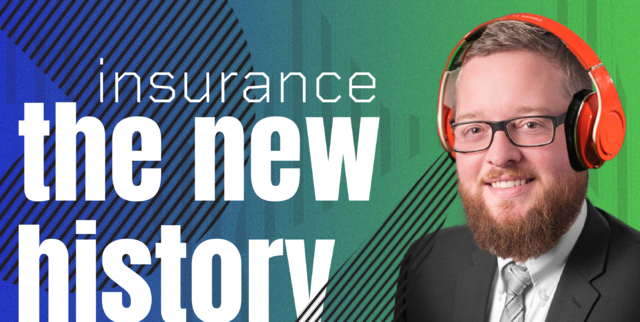Insurance: The New History
History, as we all know, is written by the victor. Winning means you get to tell your side of the story and have it live on through time as the facts as they accurately happened. How the simple passage of time elevates one person’s perspective to the absolute truth I’ll never know, but that’s how it is. In order to be history, you have to make history.
I’m going to venture into the world of insurance and tackle history with a more agile approach. In this new blog series, “Insurance: The New History” we’ll take a dive into the things happening in insurance and around insurance now, or things that I think will be a major player in the industry very soon. This is my perspective on the what, the why, and the how of history-making tech in insurance.
These articles should serve as an innovation jumpstarter or, better yet, get companies to think “let’s try something different” instead of “this is the way we’ve always done it; this is the way we’ll keep doing it.”
I’m hoping this helps people in insurance be the victor, the historian of record for their own stories.
Be the disruptors, not the disrupted.

Culture first, strategy second
I’m a student of how things get done. As a kid, I spent a lot of my life tearing toys apart to see how they worked. Sometimes those toys get put back together and sometimes I mangled them beyond repair. But I always learned something.
As an adult, I transitioned that fascination to software. I’ve loved looking through code to find issues or having a challenge and searching around for the best way to solve the problem.
Last week I talked about how crucial cultural change is to working in a more modern way and solving problems more creatively in insurance.
I’m using Spotify for the purposes of this blog since I know it comes up as an example of what good (or even great) looks like in terms of modern software development methods and company culture fairly often. Yes, the Google model is fun, but not everyone can give those amenities to their employees or have the liability insurance for having a slide in their work area. Spotify is highly-respected, newsworthy, and has excellent documentation available to back up and support what I’m going to talk about.
However, you can apply this logic to any company or concept. This is just a basic framework to translate and implement best practices from outside the traditional insurance IT model. Ultimately, you are trying to change the culture of a company that may have been around for 100+ years. I can’t promise it will be easy, but it will be worth it.
What is Spotify? – Spotify is a digital music, podcast, and video streaming service that gives you access to millions of songs and other content from artists all over the world.
Why is Spotify talked about so often? They have a 95% employee satisfaction rate. They have multiple teams releasing continuously with minimal full system outages. They are a fast-growing tech company that has top talent joining their service constantly.
Describe the problems you are attempting to solve
If you are going to take on the daunting task of changing the culture at your carrier, first things first…Stop generalizing the solution. Seriously, stop it.
One thing I hear quite frequently is a statement like “we should just do what Spotify does.” This is a surefire way to get the conversation shut down immediately. By taking this approach you have minimized the amount of change that needs to happen, but more importantly you have assumed that people know what Spotify does and understand why they have done it.
Start from the beginning, look at the problems that your company has been asked to solve. This doesn’t need to be a long, drawn out process. It is even easier if you already know of an example that is out there.
For instance, following the Spotify reference (which we’ll use for the remainder of the post), there are 2 videos that are published on their engineering culture – part 1 and part 2. These videos discuss a lot about the culture they have created and some of the operating models they follow. It really gets into the heart of why they picked a key objective of driving autonomy and how they do it.
 According to their founder, Daniel Ek, they want to “aim to make mistakes faster than anyone else.” These videos are great at talking about what they are doing, but leave you to imagine why they needed to do it in the first place. They’ll call out things like focusing on agile is greater than the practices of scrum, but you’ll need to understand why they had the issues that forced them to truly believe that. I like to watch the videos and list out some of the positive outcomes that they have had and then try to reverse engineer what problem existed to need that outcome.
According to their founder, Daniel Ek, they want to “aim to make mistakes faster than anyone else.” These videos are great at talking about what they are doing, but leave you to imagine why they needed to do it in the first place. They’ll call out things like focusing on agile is greater than the practices of scrum, but you’ll need to understand why they had the issues that forced them to truly believe that. I like to watch the videos and list out some of the positive outcomes that they have had and then try to reverse engineer what problem existed to need that outcome.
Before moving on, you must describe the problems that you have that you feel could be solved (even partially) by implementing a similar model.
Prioritize the needs
Every employee hears from senior leaders and the executive team different asks, but few take the initiative to look into how we can solve this. At carriers, I’ve heard “asks” during presentations, hallway conversations, shareholder meetings, etc. These won’t come out as a formal request to an employee usually, they are the informal list of how things could be better. For an insurance carrier, here are some really common things that I see that are “needed”:
- Everyone should innovate
- Work smarter
- Move faster
- Be a diverse and inclusive culture
- Enable data driven decisions
- Protect our brand
- Enable people to make decisions
- Connect with our constituents (agent, broker, customer, employee)
- Quality is non-negotiable
- Take control of your career
- Be adaptive
- Open communication
I could go on for days and this list has things added to and taken away as times change. Things that might not have been on here before the crazy year of 2020 but now are front and center is “manage sustainable growth” or “reduce expenses”. But how do you prioritize something? Would you look at who said it? Maybe you look to what was the composition of the audience? I can tell you that none of that matters. The number 1 way to prioritize is based on culture. You might even look at the culture to help you name things differently.
I previously mentioned managing sustainable growth vs reduce expenses. If you are a company that has always had initiatives around reducing expenses, that’s great…you can use either. But if you are a carrier like most, that have never had to focus on expenses and it was all about making more premium to invest the float, I would suggest calling it “managing sustainable growth” because anything with “expense”, even though that is a priority, will never get to the top of the list and stay there. As you look through this list, keep in mind the potential cultural changes that will happen and how open the company has been before to changing these things. Along with the priority, it is also great to think about and note complexity.
When looking at prioritization, you also have to think about how you can quickly get your idea across without having to present the whole of your research in a 2-minute walk in the hallway. One way is to look at creating groupings or categorizing the list into things that really matter for your company. For most insurance companies it falls into this list and is normally the cultural priority listed, not necessarily the communicated priorities.
- Governance
- Speed
- Great place to work
Given these 3 categories and their priorities, my research would look like this:
- Governance
- Enable data-driven decisions
- Protect our brand
- Quality is non-negotiable
- Speed
- Everyone should innovate
- Work smarter
- Move faster
- Connect with our constituents (agent, broker, customer, employee)
- Enable people to make decisions
- Be adaptive
- Open Communication
- Great place to work
- Everyone should innovate
- Be a diverse and inclusive culture
- Connect with our constituents (agent, broker, customer, employee)
- Enable people to make decisions
- Take control of your career
- Be adaptive
- Open Communication
One thing that I really hope you notice is that some of the needs actually fit into multiple categories. When prioritizing, ensure that you look at how this is listed and the description. Note that it shows up in many areas.
Now is it time to mention using the Spotify Model??
Yes, now is time…well almost. Before jumping into a model and saying “Spotify” has fixed this, think about how a decision process happens. The first step is acknowledging a problem exists that you need to invest, second is asking yourself “what do I really need” as opposed to “I need all of this”, and the third is what options do I have to solve the model. Leaders in the insurance industry don’t just want you to solve the problem, they want you to own the process.
You must communicate very clearly options to solve the problem and one major option is doing nothing. A model that you want to follow is just that, a model, it isn’t a prescriptive way to tell you exactly how to do something. What makes that option better than others? Be prepared to have that conversation. Just like when we were all growing up, parents would say “if Little Johnny was jumping off a bridge, would you do it too.” I’m not sure why Little Johnny was always the bad one, but my answer was always, “it depends”. And being a former architect, it still is. What if you were jumping because of danger? What if it was just for fun? What if you measured the depth of the water, the current, the composition of the river bottom, and calculated your force of impact by using F=mg when 9.820 m/s2, when GM = 3.986×1014 m3/s2, and R=6.371×106m? Context, research, and imparting wisdom will always prevail.
 Take a look at the research you have done, the videos that are there, and what you have learned from them. Create a rough outline of how you could use the things that Spotify did to enable better governance. An example would be for “protecting our brand”. Use what Spotify calls “minimizing the blast radius”. Explain that by minimizing the features that are being released in each release cycle and having smaller team sizes that control their own release with feature flagging, you would minimize the problems that could come up if a user has a problem, or you could turn that feature off until you figured out the bug. By enabling feature flagging, smaller continuous releases with less features, and enabling decision making to be pushed down, the company is able to minimize the outage that would occur. Not once did I mention “Spotify does this…”. Own the solution, own defining what that means to you, the carrier. Avoid bringing in “best practices”, other companies, examples of how others do it, and make it your own.
Take a look at the research you have done, the videos that are there, and what you have learned from them. Create a rough outline of how you could use the things that Spotify did to enable better governance. An example would be for “protecting our brand”. Use what Spotify calls “minimizing the blast radius”. Explain that by minimizing the features that are being released in each release cycle and having smaller team sizes that control their own release with feature flagging, you would minimize the problems that could come up if a user has a problem, or you could turn that feature off until you figured out the bug. By enabling feature flagging, smaller continuous releases with less features, and enabling decision making to be pushed down, the company is able to minimize the outage that would occur. Not once did I mention “Spotify does this…”. Own the solution, own defining what that means to you, the carrier. Avoid bringing in “best practices”, other companies, examples of how others do it, and make it your own.
Ok, NOW you can mention Spotify…kind of
The mentioning of a model to your insurance leaders should only be in support of your proposal. All insurance companies are different, or at least that is what they would all like us to believe. Going back to the beginning, your culture will dictate the type of conversation you need to have. If your company is comfortable with hearing “company X does this and we should too”, then more power to you and utilize that (I wish my world was that easy). But if you are like most carriers, they want to hear that they are different AND that what they are doing that is different can be seen in other places outside of the industry, like Spotify.
It is always great to follow this process or something similar: Research the needs à Prioritize à Give Solution options à Reinforce with model. I love to include references to “who else is doing this” as an afterthought, almost as a “oh and btw, Spotify does this and has seen growth double and are still maintaining dominance in the market while keeping a 95% employee satisfaction rate”.
When you are in these conversations, act like you don’t have it all together and that you’ll need “the team” to help test what might be best for your insurance company. Most company cultures love when they hear that people are working well with others, so pander to that…better yet, believe it and do it. Culture change and even simpler, changing someone’s mind requires people to work together.
Time to take apart your own toys
At the end of the day, most people gain satisfaction by seeing their idea hit the real world. If you feel like “no one is listening” or your ideas always get stopped along the process, try using these techniques. It never helps to learn other techniques too. For instance, one that I really like for change management is the ADKAR Model.
All of these tools can help you be a better employee, but more importantly a happier employee. You might be the most intelligent person in the room, but the smartest people that I know how to look at the resources they have and solve problems. Hopefully, you can take this knowledge and apply it to parts of the culture that you feel need change. This also translates really well to selling ANY idea you have.
Practice these concepts at home. Use your significant other, children, family as test subjects. (My kids didn’t just magically start liking green vegetables, they were changed to like them.)
Send me an email, LinkedIn message, or any other contact to tell me if this worked for you and how it helped you make the changes that you knew the company needed. I hope you succeed. I’m always curious to learn about how people took their toys apart, and marvel at the even cooler thing they built from the pieces.

